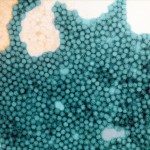Lien vers Pubmed [PMID] – 8995689
J. Virol. 1997 Feb;71(2):1621-8
Poliovirus (PV) is the causal agent of paralytic poliomyelitis. Many survivors of the acute disease, after decades of clinical stability, develop new muscular symptoms called postpolio syndrome. It has been hypothesized that the persistence of PV in the spinal cord is involved in the etiology of this syndrome. To investigate the ability of PV to persist in the spinal cord after the onset of paralysis, we exploited a mouse model in which most animals inoculated with a mouse-adapted mutant survived after the onset of paralysis. Light microscopy and ultrastructural immunohistochemical studies and reverse transcription followed by nested PCR performed on spinal cord from paralyzed mice demonstrated that PV persisted in the mouse spinal cord for at least 12 months after the onset of paralysis. This mouse model provides a new tool for studying poliomyelitis evolution after the onset of paralysis.
